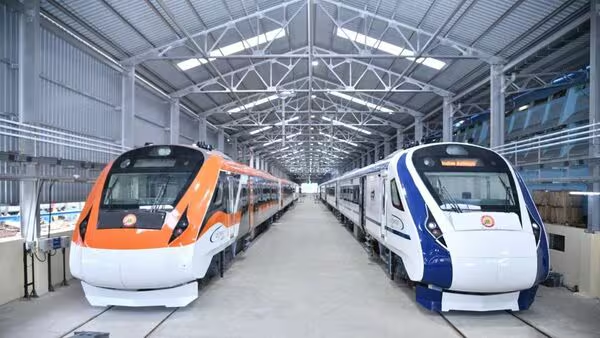New Delhi | A landmark chapter in India’s railway revolution was written on November 8, 2025, when Prime Minister Narendra Modi flagged off four new Vande Bharat Express trains from his parliamentary constituency, Varanasi (Banaras). The Banaras–Khajuraho Vande Bharat was launched in person, while the Ernakulam–Bengaluru, Lucknow–Saharanpur, and Firozpur–Delhi Cantt trains were inaugurated via video conference.
This was not merely a flagging-off ceremony; it was a celebration of the spirit of “New India – Fast India,” symbolizing the pace of progress running on every railway track of the nation.
“Vande Bharat trains are the embodiment of Atmanirbhar Bharat’s engineering excellence and the confidence of a new generation,” Prime Minister Modi said. “These trains don’t just connect cities — they connect hearts. India’s speed is now unstoppable.”
Ernakulam–Bengaluru Vande Bharat: South India’s New Symbol of Progress
Among the four new trains, the Ernakulam–Bengaluru Vande Bharat Express has drawn special attention as a symbol of South India’s technological, cultural, and economic integration. Connecting Kerala’s cultural capital Ernakulam (Kochi) with Karnataka’s technology hub Bengaluru, the 575 km journey takes just 8 hours and 40 minutes — almost two hours less than conventional trains.
Running daily in both directions, the train enables “same-day return” travel — a boon for business professionals, IT employees, and family commuters alike.
The train halts at seven key industrial and cultural stations — Coimbatore, Tiruppur, Erode, Salem, Palakkad, Thrissur, and Ernakulam. These cities represent the industrial and agricultural lifeline of southern India. Coimbatore, known as the Manchester of South India, and Erode and Salem, renowned for textiles and small industries, will now enjoy faster access to major markets.
A Technological Marvel, Made in India
The Ernakulam–Bengaluru Vande Bharat Express has been entirely designed and built by the Integral Coach Factory (ICF), Chennai, representing the success of the Make in India initiative and India’s engineering prowess.
Key features include:
- Aerodynamic design ensuring high speed and stability.
- Energy-efficient systems that reduce fuel consumption.
- Bio-vacuum toilets and automatic doors combining hygiene with convenience.
- GPS-based real-time passenger information systems.
- Reclining seats for fatigue-free comfort during long journeys.
Environmentally, the train is a model of green mobility, with energy-efficient propulsion systems that cut carbon emissions and reduce diesel use significantly.
Economic and Environmental Gains
The Ernakulam–Bengaluru corridor strengthens trade links between Kerala’s port-based industries, Bengaluru’s IT sector, and Coimbatore’s textile economy. Faster movement of goods and workforce mobility will reduce logistics costs and boost productivity.
Environmentally, the train represents India’s transition to low-emission electric mobility, contributing directly to the country’s climate goals.

Tourism and Cultural Connectivity
The route connects regions rich in tourism, history, and spirituality — from Ernakulam’s backwaters and Kochi’s heritage ports to the temples of Tiruppur, the hills of Salem, and the urban vibrancy of Bengaluru.
“Tourism in India is not just an economic activity; it is an emotion,” the Prime Minister remarked. “When our railways become modern, our pilgrimage, tourism, and trade all receive equal momentum.”
Four Vande Bharats, One Vision — New India, Developed India
Alongside the Ernakulam–Bengaluru line, three other Vande Bharat Express trains were dedicated to the nation:
- Banaras–Khajuraho Vande Bharat Express: Connecting major religious and cultural centers of North India.
- Lucknow–Saharanpur Vande Bharat Express: Enhancing industrial connectivity across Uttar Pradesh.
- Firozpur–Delhi Cantt Vande Bharat Express: Linking Punjab’s border belt to the national capital.
With these additions, over 80 Vande Bharat trains are now operational across India, expanding the network of speed, comfort, and modernity across the rail map.
“A Decade of Rail Revolution”
Prime Minister Modi described the last ten years as an era of unprecedented railway transformation, powered by 140 crore Indians’ collective strength rather than any single government’s effort.
The Railways Ministry aims to connect all major Indian cities through high-speed, high-tech trains like Vande Bharat, reducing travel time, boosting efficiency, and elevating the passenger experience to global standards.
The Tracks of Progress
The Ernakulam–Bengaluru Vande Bharat Express is more than a train — it is a moving symbol of India’s self-reliance, innovation, and progress. It signifies not only faster travel but also safer, cleaner, and more enjoyable journeys.
When it embarked on its maiden trip on November 8, 2025, South India witnessed more than just a new train — it saw the momentum of development itself.
The new Vande Bharat Express is not merely a transport service — it is the heartbeat of a modern, self-confident, and resurgent India.






